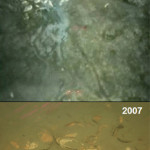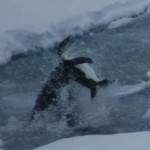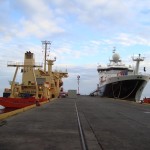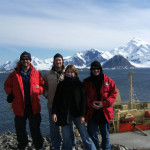 David Honig is a graduate student in marine science at Duke University in the lab of Dr. Cindy Van Dover. He is participating in LARISSA, a 2 month multinational expedition to study the causes and consequences of the ice shelf collapse. He will be posting regular updates on the expedition exclusively for Deep Sea News readers!
David Honig is a graduate student in marine science at Duke University in the lab of Dr. Cindy Van Dover. He is participating in LARISSA, a 2 month multinational expedition to study the causes and consequences of the ice shelf collapse. He will be posting regular updates on the expedition exclusively for Deep Sea News readers!
——————————
2 February 2010
One month into LARISSA, one month to go: a summary of progress and an outline of remaining cruise objectives

It has been one month since the “LARsen Ice Shelf System, Antarctica” (LARISSA) science team left port in Punta Arenas, Chile bound for the rapidly-disappearing Larsen Ice Shelf System. Our main target was the embayment formerly occupied by the Larsen B Ice Shelf—a 75-story-tall floating slab of ice the size of Rhode Island that disintegrated over the course of just four weeks in 2002—and the even larger Larsen C Ice Shelf immediately to the south that may be nearing a catastrophic, Larsen-B-style collapse. LARISSA plans to use the Larsen B and C Ice Shelves as a model system for understanding why Antarctic ice shelves collapse, how often they collapse, and what effect such rapid disintegration has on underlying marine communities.
Unfortunately, it is now February and we have yet to reach the Larsen B embayment. The Weddell Sea was choked with rotten fast ice in January and the Palmer could not push far enough south to reach the Larsen B. “Fast ice” forms on the sea surface (as opposed to ice shelves which form on land as glaciers) and can be anywhere from a few inches to tens of feet thick. “Rotten” fast ice contains pockets of slush. The RVIB in RVIB Nathaniel B. Palmer stands for “research vessel ice breaker,” but the ship is designed to break through hard fast ice that cracks into rigid fragments the ship can easily push aside into piles. Trying to break rotten fast ice is like pushing aside toothpaste—progress is slow and pressure the ice exerts against the hull can reach dangerously high levels.
Instead of fighting a perilous and futile battle against miles of rotten fast ice, we moved into fjords west of the Antarctic Peninsula. From there, we reasoned we could use the two helicopters on board to install monitoring equipment on the glaciers that flow into the Larsen B and C embayments. Meanwhile, our ship-bound scientists could extract sediment, invertebrates, and other data from the fjords relevant to LARISSA objectives. After nearly three weeks west of the Antarctic Peninsula, we have now returned to the Weddell Sea for a final assault on the Larsen B. It is a good time to review our progress thus far. What have we accomplished? What remains to be done?
Work thus far has contributed to several key LARISSA objectives:
Constrain past configuration of the Antarctic Peninsula Ice Sheet. The Larsen Ice Shelf System is the remnant of a vast ice sheet known as the Antarctic Peninsula Ice Sheet (APIS) that stretched into South America 20,000 years ago during the peak of the last ice age, a time known as the Last Glacial Maximum. Since the last glacial maximum, the APIS has retreated to its current position. How quickly did the retreat take? Was it punctuated by collapse events similar to the disintegration of the Larsen B?
Link past APIS configuration to paleoclimate. Correlating past climatic conditions with Larsen-B-style collapse events during the APIS retreat will lend insight into why ice shelves are disintegrating today.
Characterize glacial response to ice shelf collapse. Ice shelves are glaciers that have spilled out into the ocean. The Larsen B was fed by several tributary glaciers that now terminate at open water. How do these glaciers respond to loss of the Larsen B?
- To address this question, our glaciology team has thus far installed one of six planned AMIGOS (“Automated Meteorological-Ice-Geophysics Observation Stations”) on glaciers feeding into the Larsen B embayment. The AMIGOS will simultaneously track glacier movement, appearance (e.g. presence/absence of melt ponds, large cracks, etc.), and weather to understand how the effects of ice-shelf collapse propagate out onto the surrounding land.
In addition to ticking-off a few geology and glaciology-related cruise objectives, our time west of the Peninsula allowed us to complete . . .
Opportunistic oceanography in Western Antarctic Peninsula fjords. Ice-shelf disintegration is propagating south along the eastern side of the Antarctic Peninsula. Are glaciers that empty into fjords on the western side of the Antarctic Peninsula experiencing a similar phenomenon? How are marine ecosystems changing in response? Our marine ecosystems team took advantage of time in the fjords to capture a snapshot of currents, primary production, and benthic diversity using the following tools:
All in all, most of the work we had originally planned remains to be completed (see map above). Notably absent from our list of accomplishments is any mention of cold seeps, sampling fauna from which is the primary reason I am aboard (more about this in a later entry). Luckily, our patience may have paid off: the rotten fast ice is softer and laced with floes of pack ice (floating ice chunks)—that the Palmer may now be able to navigate. Surrounded by the deafening roar of pack ice scraping against the hull as the Palmer plods southward, we are keeping our fingers crossed that the Larsen B will be navigable and our planned fieldwork can be completed.





